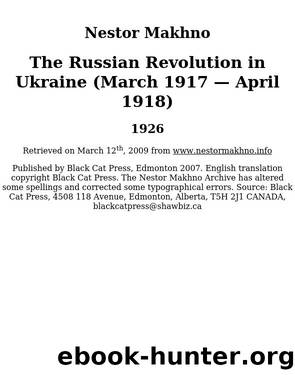The Russian Revolution in Ukraine (March 1917 â April 1918) by Nestor Makhno & Nestor Makhno

Author:Nestor Makhno & Nestor Makhno
Language: eng
Format: epub
Tags: history, Russian Revolution
Published: 1926-08-14T16:00:00+00:00
Chapter 19: Counter-Revolution of the Ukrainian Central Rada
At the end of the Congress, the delegates dispersed to their homes. We, Comrade Mironov and I, went to the Anarchist Federation with the intention of finding some good propagandists we could take back with us to the countryside. The Federation was in a better state than when I visited it in August while attending the Provincial Congress of Peasants and Workers. At that time I visited its various sections (the club, etc.). The Federation was still rather weak â it was barely able to tend to the city and its adjacent settlements â Amur, Nizhne-Dneprovsk, and Kaidaki. And yet the Federation was rich in armaments: carbines, rifles, and cartridges. In view of the unusual situation holding sway in the city, the Bolshevik â Left-SR authorities had freely issued weapons to the Ekaterinoslav Federation of Anarchists, without any control whatsoever.
The Bloc saw the Federation of Anarchists as true revolutionaries who spurned the Ukrainian nationalists, backed up as they were by the bourgeoisie and generally in the camp of the Counter-Revolution. The Bloc used the enthusiasm, firm belief, and devotion to the Revolution of the Ekaterinoslav anarchists in every serious revolutionary crisis.
Having these weapons at its disposal, the Federation issued several boxes of rifles to us for the Gulyai-Pole Anarchist Communist Group. We loaded these weapons on the train and travelled back to Gulyai-Pole.
In Gulyai-Pole we made a series of reports about the Congress and all the obstacles which stood in its way. Subsequently we made similar reports in other villages and settlements.
From this time Gulyai-Pole raion began to arm itself in earnest and exercise vigilance towards the new revolutionary masters. The notion that these new masters â the Bolsheviks and the Left S-Rs â would also hinder the creative development of free thought and action by the toilers of the oppressed villages little by little began to be confirmed even in the minds of those toilers who wanted to believe in the Left Bloc.
The peasants and workers learned from their delegates that the Bolshevik Epstein stated at the Congress: âThe urban proletariat has come to power and one must hope that it will create its own state â a Proletarian State. We, the Bolsheviks, will devote all our strength to helping it create such a State, because this is the only way the proletariat will achieve the happiness it seeks.â
The toilers of Gulyai-Pole interpreted these words as saying that the Bolshevik Party, abandoning all scruples, would build its own âproletarianâ State at the expense of the peasants. They began anxiously to follow the course of events in the cities.
In the villages, the peasants began to teach each other how to handle rifle.
âOur enemies, the authorities,â they said, âare armed, and if they decide to deprive us of our right to an independent existence and the right to create new social structures, then they will launch an attack on us. Consequently, we must be prepared to reply in kind.â
So the peasants prepared. In Gulyai-Pole itself there were people from the poor peasantry who had received serious military training.
Download
This site does not store any files on its server. We only index and link to content provided by other sites. Please contact the content providers to delete copyright contents if any and email us, we'll remove relevant links or contents immediately.
| Africa | Americas |
| Arctic & Antarctica | Asia |
| Australia & Oceania | Europe |
| Middle East | Russia |
| United States | World |
| Ancient Civilizations | Military |
| Historical Study & Educational Resources |
Rasputin by Joseph T. Fuhrmann(561)
Russian Revolution: A Concise History From Beginning to End (October Revolution, Russian Civil War, Nicholas II, Bolshevik, 1917. Lenin) (One Hour History Revolution Book 3) by Hourly History(334)
The Russian Revolution: A Very Short Introduction (Very Short Introductions) by S. A. Smith(333)
FROM RUSSIA, WITH LOVE by Ian Fleming(323)
Moscow Monumental by Katherine Zubovich(321)
The Russian Five by Keith Gave(310)
Reconstructing Lenin: An Intellectual Biography by Krausz Tamás(303)
Authoritarian Nightmare by John W. Dean & Bob Altemeyer(300)
Winter is Coming by Gary Kasparov(297)
Kremlin Rising by Peter Baker(274)
Io dirò la verità by Germano Maifreda(258)
Spetsnaz: The Inside Story of the Soviet Special Forces by Viktor Suvorov(243)
Russia Resurrected by Kathryn E. Stoner;(235)
My Further Disillusionment in Russia by Emma Goldman(233)
Voices From Stalingrad by Bastable Jonathan;(227)
13 KGB by Unknown(217)
The Russian Revolution in Ukraine (March 1917 â April 1918) by Nestor Makhno & Nestor Makhno(212)
Jihad and Death by Roy Olivier;(201)
Russian Revolution, 1917 (9781108109161) by Wade Rex A(188)
